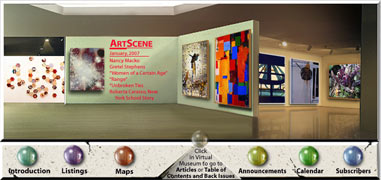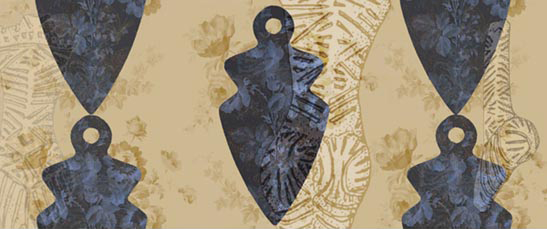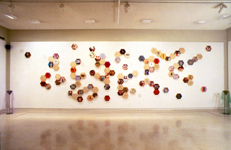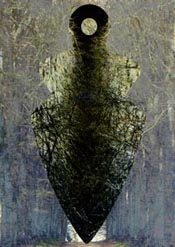JANUARY, 2007 PREVIEW |
|
 |

|
HIVE UNIVERSE: NANCY MACKO, 1994 - 2006December 15 - February 4, 2007 at Municipal Art Gallery, Barnsdall Park, Hollywoodby Judith Christensen |
"The Honeycomb Wall" (detail), 1993-94,
| Feared by many, loved by few, we depend on their services in our agricultural production cycle. As they gather what they need to produce their own food and shelter, we become the fortunate beneficiaries as bees spread pollen from flower to flower, fertilizing our crops. This phenomenon forms the basis for the symbiotic relationship between beekeeper and farmer and between humans and bees, interactions that express the potentially harmonious relationships Nancy Macko searches for and explores in her artwork. No wonder bees have been fundamental in her quest. Since the early 1990’s, the apian world has informed the structure and content of her work, provided a metaphorical framework for her investigations, has served as a conduit to further studies, and even served as media, in the form of wax, pollen and the honey itself. |
| Like the bees’ natural system of honeycombs or the beekeepers’ arrangement of parallel frames in a hive body, layering has been intrinsic to Macko’s work since her early printmaking. She embossed, monoprinted, collaged, drew and painted on a single surface. She now utilizes the layer feature contained in the Adobe Photoshop program in her digital prints, often incorporating imagery from other work. Photographs of a large (5 x 14 feet) painting, “Quintessence: New Constellations” (2000), function as background in her digital prints and appear as layers in her “Lore of Bee Priestess” (2004) video. “Quintessence” seems to portray the universe, populated with stars, constellations and nebulae floating in a background saturated with color--ranging from blues and greens to reds and oranges. One particularly dense cluster recalls the lacy structure of the honeycomb. Since in Macko’s universe all phenomena are interconnected, it is not surprising that she weaves together the visual vocabulary from her various investigations: bees, ancient cultures, matriarchal societies, feminist utopian novels, mathematical inquiries and cosmic imagery. How fitting, then, that “Bee Stories” (2006), an audio and video installation, has the visual form of a kaleidoscope. The colorful, morphing, hexagonal shapes complement the sounds of the overlapping stories of bees, told in different languages. Translations on the walls guide the viewer toward an understanding not accessible through the video and audio components alone. Throughout her artwork, Macko’s deep respect for nature is evident. “I hold nature and the universe in the highest esteem,” she says, “. . . it is something that we can access as individuals, that we can have a dialogue with and can also have a responsibility to.” The same is true of her art. It is accessible, rich enough to have a dialogue with and, if we do engage in that dialogue, it can elicit in us a sense of responsibility. |
 "Dark Aging," 2004, digital print, 50 X 120 ". |



